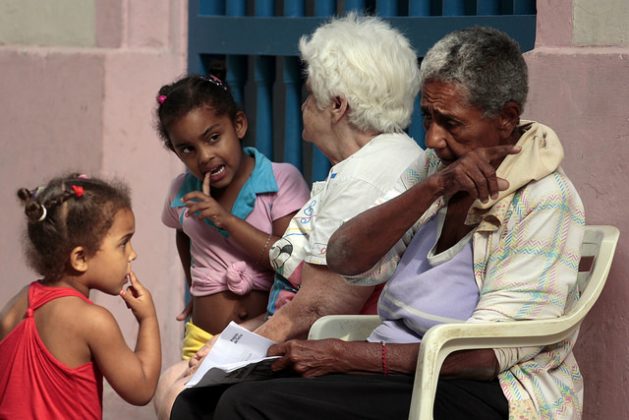Monday, May 20, 2024
News and Views from the Global South
Education
A Possible Childcare Solution

Two grandmothers sit with their granddaughters, whom they take care of while their mothers work, on a street in the historic centre of Old Havana, Cuba. Credit: Jorge Luis Baños/IPS
- A possible solution to childcare needs is polygamy. Polygamy, the practice of having more than one spouse at the same time, was not against the laws in many countries in the past. For example, polygamy was made illegal in China in 1950, in France at the end of the 20th century, in the United States near end of the 19th century and became a felony in the United Kingdom at the start of the 17th century.
Today nearly four dozen countries worldwide, representing about one-fifth of the world’s population, permit polygamy, including Afghanistan, Bangladesh, Egypt, Indonesia, Iran, Iraq, Nigeria, Pakistan, Saudi Arabia and Tanzania. In addition, some countries, such as France, Germany, Sweden, Switzerland and the United Kingdom, recognize polygamous marriages that were done in a country that permits polygamy.
Religions have differing views about marriage and polygamy. For instance, Islam permits a man to have up to four wives, and Hinduism and the Anglican Communion allows polygamy in certain circumstances and the Lutheran Church accepts some polygamists.
Polygamy will not require additional government spending nor create a new entitlement, such as national pension programs, which largely benefit the elderly and retired persons, but not families with young children. Also, it will make childcare needs, such as daycare services, universal pre-primary school education, child tax credits and after school care, unnecessary.
Fiscal conservatives will be pleased to establish polygamy as it avoids establishing new entitlements and additional government expenditures for childcare benefits. Also, it would not contribute to national deficits nor negatively impact a country’s economy.
Also importantly, permitting men and women to have additional spouses, perhaps with a limit of no more than seven spouses, can be expected to substantially increase overall household income. That additional income from several employed spouses will likely move many households above the poverty threshold.
In addition, polygamy would permit one spouse to stay at home to care for children and carry out household responsibilities, with this role possibly rotating among the spouses. The other spouses would then be able to participate in the labor force and pursue their careers and professions. Many married working couples, especially those with demanding schedules, often say, “What we really need is an additional spouse in the house”.
A further potential benefit of polygamy is reducing the need for divorce. Instead of a married couple resorting to a costly and disruptive divorce, they could choose to remain married and simply add additional spouses to their household.
Also, polygamy can be expected to reduce the incidence of marital infidelity. With several spouses in the household, one has an increased number of available sexual partners.
Despite polygamy’s advantages, it’s unlikely that countries will choose to establish the right to polygamy any time soon. The practice is increasingly uncommon, with 2 percent of the global population live in polygamous households and in most countries that proportion is less than 0.5 percent.
In addition, studies report a more significant prevalence of mental-health issues, especially among women, in polygamous relationships compared to monogamous relationships. Polygamy also creates harmful competition among males that contributes to societal instability and insecurity.
Moreover, the United Nations Human Rights Committee has called for polygamy to be abolished as it violates the dignity of women. Some countries that recognize polygamous marriages conducted in another country are taking steps to stop the recognition altogether. Also, several Muslim countries have prohibited polygamy, such as Turkey in 1926 and Tunisia in 1956, largely because it was concluded that a husband could not treat his spouses with equal fairness.
Consequently, it’s evident that other options are needed to address childcare needs. In particular, those needs are seriously limiting the employment of parents, especially single-parent families and low-income mothers, influencing fertility decisions, and negatively impacting household income and national economies.
Of the world’s 2.4 billion children 14 percent – or about 330 million – are living in single-parent households, most often headed by single mothers. Those children and their single parents face social and economic challenges.
The United States has one of the highest levels of single-parent families with children. Approximately 30 percent of America’s families with children less than 18 years old, some 10 million households, are single-parent households. The percentage of U.S. families with children living with a single parent, typically a mother, has tripled since 1965.
Furthermore, childcare needs are adversely impacting the cognitive, educational and health development of children, particularly those in low-income households. Again in the United States, the proposed expanded child tax credits are expected to cut child poverty by about 40 percent, from about 14 to 8 percent.
Worldwide it is estimated that more than 40 percent of all children below primary-school age – or nearly 350 million – need childcare services but do not have access. Too often, many of those young children spend much of their time in vulnerable and unstimulating environments. Notable exceptions are among wealthy developed countries.
OECD countries spend on average 0.7 percent of GDP annually for childcare and pre-primary education, ranging from highs of 1.8 percent in Iceland and 1.6 percent in Sweden to lows of 0.3 percent in the United States and 0.2 percent in Turkey. Among the 33 member nations of OECD, the U.S. ranks 30th in public spending on families and children, which includes childcare support (Figure 1).
In many countries the lack of affordable, available and reliable childcare is keeping many parents, especially mothers, from actively participating in the labor force and reducing household earnings. Parents too often face employment decisions based on childcare needs rather than financial or career considerations. When childcare consumes much of a parent’s time and income, some, typically mothers, decide to leave the labor force.
The lack of childcare is also affecting fertility levels. In China, for example, the lack of access to affordable and convenient childcare options is an important reason why couples aren’t having more children. Of the nearly 50 million Chinese children under 3 years old, approximately 5 percent of them use day care services.
Among most wealthy developed countries, however, the enrolment of 3- to 5-year-old children in early childhood education and childcare services is relatively high, well above 80 percent. Again, a notable exception is the United States where the enrolment in early childhood education and childcare services is 66 percent, well below the OECD average of 87 percent (Figure 2).
It is becoming increasingly evident that meeting childcare needs and the labor force participation of parents, especially mothers, are closely linked to a nation’s overall economic growth. Some maintain that a country cannot be prosperous with half of its workforce sitting on the sidelines due to the lack of affordable childcare and pre-primary education.
The establishment of programs and policies to meet childcare needs and pre-primary education not only contributes to the development and wellbeing of children, their families and communities, it is also a prudent investment contributing to the economic, social and human development of a nation.
Joseph Chamie is a consulting demographer, a former director of the United Nations Population Division and author of numerous publications on population issues, including his recent book, “Births, Deaths, Migrations and Other Important Population Matters.”

 Print
Print





